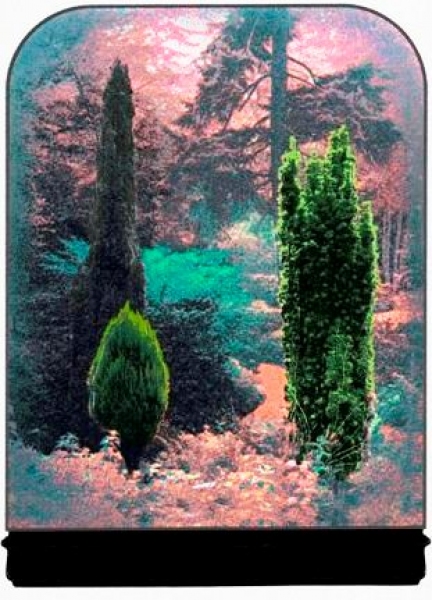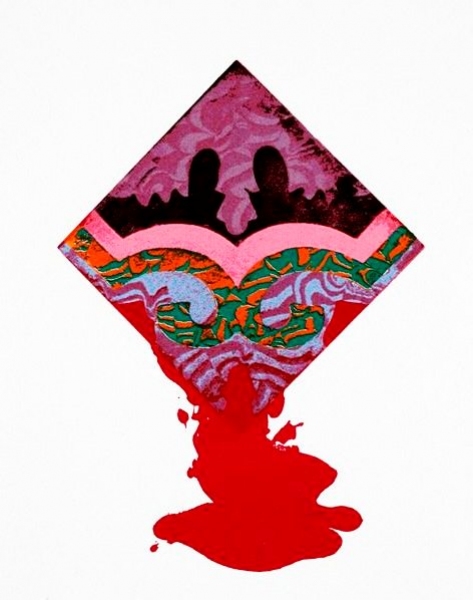Ivor Abrahams, Mystery and Imagination, Royal Academy | reviews, news & interviews
Ivor Abrahams, Mystery and Imagination, Royal Academy
Ivor Abrahams, Mystery and Imagination, Royal Academy
A print show that is tart and sweet, small but perfectly formed
In this month of royal weddings, endless bank holidays and (possibly?) equally endless good weather, it can be hard to focus, so perhaps this is the perfect opportunity to catch up with a show that nearly got away. Instead of winsome blockbusters like Tate Modern’s Miró, or the V&A’s The Cult of Beauty, Ivor Abrahams' print show is tart as well as sweet, small but perfectly formed, the ideal restorative after too much sugar, whether in wedding cakes or art galleries.
Ivor Abrahams is perhaps better known as a sculptor, studying under Anthony Caro in the 1950s, and first exhibiting, with Peter Blake, in the 1960s. Both of these artists seem to impinge on this print show, in delightfully unexpected ways.
Two literary sources are the jumping-off point for Abrahams here: Edgar Allan Poe’s Tales and Poems and Edmund Burke’s A Philosophical Enquiry into the Origin of Our Ideas of the Sublime and Beautiful. At first, there does not appear to be much to link the two: Burke’s work first appeared in 1757, Poe’s more than 75 years later; Burke’s is a philosophical treatise, Poe’s are literary explorations of the uncanny, the odd and the mysterious.
The prints with the overall appellation To Edmund Burke (1978-9) have no titles, but a panel of quotations from Burke’s work appears beside them. These indicate that the individual prints are not illustrations, but are created as a whole to encompass the moods of Burke’s work. The key citation would appear to be: “No passion so effectually robs the mind of all its powers of acting and reasoning as fear.” This, surely, is the link between the two series, for Poe’s work hovers around fear like wasps around some jam.
Yet oddly, while fear, uncertainty, grief, longing and mourning are all clearly the starting points for Abrahams, the prints themselves are wonderfully serene. They encapsulate the emotions almost literally, sealing them in via Abrahams' own lyrical skills and his measured and yet lush use of colour. The 20 Poe screenprints recapitulate the stories in a similar way. Those familiar with Poe’s tales and poems will be able to pick out elements – here, the raven, there, the prematurely buried figure. But while this time Abrahams does give us clues, by using Poe's titles for each image, these are not literal, or illustrative, renditions, but once again appear to be mood-influenced reveries.
The 20 Poe screenprints recapitulate the stories in a similar way. Those familiar with Poe’s tales and poems will be able to pick out elements – here, the raven, there, the prematurely buried figure. But while this time Abrahams does give us clues, by using Poe's titles for each image, these are not literal, or illustrative, renditions, but once again appear to be mood-influenced reveries.
Trompe-l’oeil depth and verisimilitude are used to remarkable effect in some of the prints. The Premature Burial has a white tomb-shaped box, without actually being either a tomb or a coffin; yet it is rendered in sharply realistic detail, which gives a vertiginous yes/no reading. Do we know what this box is? The trompe-l’oeil effect tells our eyes we must know, while our brains record that it is in fact left undefined. The dark-red fabric caught in the opening, therefore, gains a sense of foreboding because of the unresolved nature of our vision.
A Dream Within a Dream (main picture, above) has a Magritte-ish sense of illusionism too: in the top half, sand runs through the hour-glasses, warning that the end is at hand; on the bottom level, however, the sand illusionistically sits at the "wrong" end for gravity to be functioning. The same push-pull once again is neatly effected by Abrahams, once again wrong-footing the viewer.
 Everything has the air of a dream yet, strangely, given the iconography, they are dreams without menace. Domain of Arnheim (pictured above, right) is a lush secret garden, yet in the "wrong" colours, pinks and saturated greens blending and creating a hypnotic pattern that makes one believe, none the less, that this is what has always been, as one does in a dream. Even one of Poe’s most terrifying stories, The Masque of the Red Death becomes a symbolic, but not frightening, image (pictured left), a triangle of beautiful pattern spilling yet more beautiful blood.
Everything has the air of a dream yet, strangely, given the iconography, they are dreams without menace. Domain of Arnheim (pictured above, right) is a lush secret garden, yet in the "wrong" colours, pinks and saturated greens blending and creating a hypnotic pattern that makes one believe, none the less, that this is what has always been, as one does in a dream. Even one of Poe’s most terrifying stories, The Masque of the Red Death becomes a symbolic, but not frightening, image (pictured left), a triangle of beautiful pattern spilling yet more beautiful blood.
There is claustrophobia here, but such intense lyrical beauty that it is impossible to be oppressed. For while Burke’s notions of the terrible and the sublime may be oppressive, as in Abrahams' image of the headless, armless, high-heeled woman running endlessly, yet once in Poe’s vivid world, instead of the terrible, a terrible beauty is born.
- Ivor Abrahams: Mystery and Imagination at the Royal Academy until 22 May
 Find Ivor Abrahams on Amazon
Find Ivor Abrahams on Amazon
Share this article
more Visual arts
 Yinka Shonibare: Suspended States, Serpentine Gallery review - pure delight
Weighty subject matter treated with the lightest of touch
Yinka Shonibare: Suspended States, Serpentine Gallery review - pure delight
Weighty subject matter treated with the lightest of touch
 Jane Harris: Ellipse, Frac Nouvelle-Aquitaine MÉCA, Bordeaux review - ovals to the fore
Persistence and conviction in the works of the late English painter
Jane Harris: Ellipse, Frac Nouvelle-Aquitaine MÉCA, Bordeaux review - ovals to the fore
Persistence and conviction in the works of the late English painter
 Sargent and Fashion, Tate Britain review - portraiture as a performance
London’s elite posing dressed up to the nines
Sargent and Fashion, Tate Britain review - portraiture as a performance
London’s elite posing dressed up to the nines
 Zineb Sedira: Dreams Have No Titles, Whitechapel Gallery review - a disorientating mix of fact and fiction
An exhibition that begs the question 'What and where is home?'
Zineb Sedira: Dreams Have No Titles, Whitechapel Gallery review - a disorientating mix of fact and fiction
An exhibition that begs the question 'What and where is home?'
 Yoko Ono: Music of the Mind, Tate Modern review - a fitting celebration of the early years
Acknowledgement as a major avant garde artist comes at 90
Yoko Ono: Music of the Mind, Tate Modern review - a fitting celebration of the early years
Acknowledgement as a major avant garde artist comes at 90
 Unravel: The Power and Politics of Textiles in Art, Barbican review - the fabric of dissent
An ambitious exploration of a neglected medium
Unravel: The Power and Politics of Textiles in Art, Barbican review - the fabric of dissent
An ambitious exploration of a neglected medium
 When Forms Come Alive, Hayward Gallery review - how to reduce good art to family fun
Seriously good sculptures presented as little more than playthings or jokes
When Forms Come Alive, Hayward Gallery review - how to reduce good art to family fun
Seriously good sculptures presented as little more than playthings or jokes
 Entangled Pasts 1768-now, Royal Academy review - an institution exploring its racist past
After a long, slow journey from invisibility to agency, black people finally get a look in
Entangled Pasts 1768-now, Royal Academy review - an institution exploring its racist past
After a long, slow journey from invisibility to agency, black people finally get a look in
 Barbara Kruger, Serpentine Gallery review - clever, funny and chilling installations
Exploring the lies, deceptions and hyperbole used to cajole, bully and manipulate us
Barbara Kruger, Serpentine Gallery review - clever, funny and chilling installations
Exploring the lies, deceptions and hyperbole used to cajole, bully and manipulate us
 Richard Dorment: Warhol After Warhol review - beyond criticism
A venerable art critic reflects on the darkest hearts of our aesthetic market
Richard Dorment: Warhol After Warhol review - beyond criticism
A venerable art critic reflects on the darkest hearts of our aesthetic market
 Dineo Seshee Raisibe Bopape: (ka) pheko ye / the dream to come, Kiasma, Helsinki review - psychic archaeology
The South African artist evokes the Finnish landscape in a multisensory installation
Dineo Seshee Raisibe Bopape: (ka) pheko ye / the dream to come, Kiasma, Helsinki review - psychic archaeology
The South African artist evokes the Finnish landscape in a multisensory installation
 Paul Cocksedge: Coalescence, Old Royal Naval College review - all that glitters
An installation explores the origins of a Baroque masterpiece
Paul Cocksedge: Coalescence, Old Royal Naval College review - all that glitters
An installation explores the origins of a Baroque masterpiece

Add comment